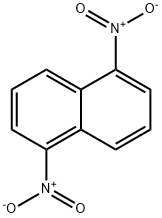Chemical Properties
Yellow to yellow-green needles or fluffy powder
Uses
1,5-Dinitronaphthalene is an intermediate in the production of naphthazarin (5,8- dihydroxy-1,4-naphthoquinone) and 1,5- naphthalenediamine, which is mainly converted to naphthalene 1,5-diisocyanate. As a sensitizing agent for ammonium nitrate explosives the use of mixed isomers is adequate.
Definition
ChEBI: 1,5-dinitronaphthalene is a dinitronaphthalene carrying nitro groups at positions 1 and 5. It has a role as a genotoxin.
Production Methods
Naphthalene is added slowly to mixed acid (22/58/20) at 40 ℃, and the temperature is raised to 80 ℃ over 4 h to give a mixture of 1,5- and 1,8-dinitronaphthalenes. The isomers are separated by fractional crystallization (e.g., from ethylene dichloride) or, preferably, by solvent extraction. The 1,5-isomer can be extracted with toluene, leaving 99 % pure 1,8- dinitronaphthalene. After evaporation of the toluene, the residue is extracted with a strongly polar solvent (e.g., sulfolane) to leave 99 % pure 1,5-isomer.
General Description
Yellowish white needles or light yellow fluffy solid.
Air & Water Reactions
Insoluble in water.
Reactivity Profile
1,5-Dinitronaphthalene is incompatible with strong oxidizers and strong bases. Mixtures with sulfur or sulfuric acid may explode if heated to 248° F .
Fire Hazard
Flash point data for 1,5-Dinitronaphthalene are not available; however, 1,5-Dinitronaphthalene is probably combustible.
Safety Profile
A suspected
carcinogen. Mutation data reported.
Mxtures with sulfur or sulfuric acid (used in
commercial reactions) may explode if heated
to 120℃. Initiation temperature depends on
the quality of the dinitronaphthalene. When
heated to decomposition it emits toxic
fumes of NOx. See also NITRO COMPOUNDS of AROMATICHYDROCARBONS



